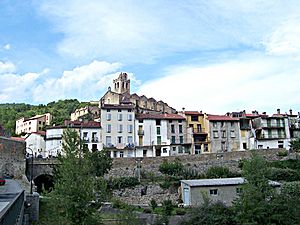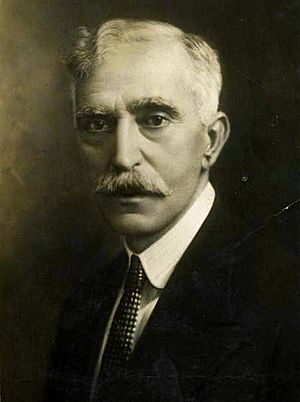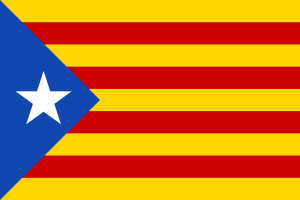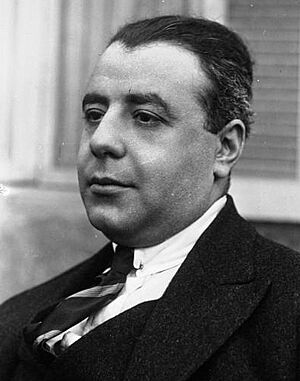Plot of Prats de Molló facts for kids
Quick facts for kids Plot of Prats de Molló |
|||||||
|---|---|---|---|---|---|---|---|
 Current view of the town of Prats de Molló i la Presta |
|||||||
|
|||||||
| Belligerents | |||||||
| Commanders and leaders | |||||||
|
|||||||
| Units involved | |||||||
| About 150 volunteers | |||||||

The Plot of Prats de Molló was a secret plan to invade Catalonia from France. It was organized by Francesc Macià and his political party, Estat Català, in 1926. Their goal was to make Catalonia independent from Spain. The plan involved two groups of people crossing the border to take over the town of Olot and then declare a new Catalan Republic. However, the plan was discovered and stopped before it could even begin.
Planning the Invasion
When Miguel Primo de Rivera took control of Spain in 1923, he started policies that were against Catalan culture and rights. This made Estat Català and its leader, Francesc Macià, believe that an armed uprising was the only way forward. Macià, who was 64 at the time, wanted to unite different groups, including workers and other nationalist parties, to end the dictatorship.
He set up a special committee in Paris to lead the uprising. They also started raising money to buy weapons. Macià also tried to get international support. He formed a group called the League of Oppressed Nations. His main idea was to invade a small part of Catalonia. This would draw global attention to the "Catalan case" and force a solution.
In 1925, Macià met with other groups, including some from the Basque Country. They planned a joint uprising in Catalonia and the Basque Country. To pay for this, they started a special loan called the Pau Claris loan. Weapons were hidden near the French-Spanish border. However, French police were watching Macià closely because of his plans against the Spanish government.
Around this time, another group linked to Estat Català tried a separate attack against the Spanish king and queen. This was known as the Garraf plot, but it also failed.
Macià even traveled to Moscow to get help from the Soviet government. He met with important leaders who promised money and military support. However, this help never arrived because those leaders lost their power. Macià later decided to stop working with the communists. He felt they did not keep their promises.
The Plan Unfolds
After another failed uprising attempt in Spain in June 1926, Macià decided to go ahead with his plan to invade Catalonia from France. He believed it was important to do something, even if it didn't guarantee full freedom.
Macià's plan was for his groups, called escamots, to enter Catalonia through Prats de Molló. After taking Olot, they would head to Barcelona. In Barcelona, a general strike would be called, and the Catalan Republic would be declared. They hoped this would inspire uprisings in other parts of Spain.
In Paris, Macià also connected with a group of Italian exiles. Some of these Italians had fought in World War I. Macià hoped their military experience would help his less experienced escamots. However, it turned out that one of the main Italian contacts was secretly working for the Italian police. This meant the Spanish government, led by Miguel Primo de Rivera, soon found out about the invasion plan.
The attack plan involved two armed groups crossing the border at dawn. They would use mountain paths to reach the edge of Olot. More groups would join them there. Their goal was to surprise the local police and military. They also planned to bring a radio station to announce the new Catalan Republic. They hoped this news would make the Catalan people rise up. After Olot, they would move to a mountain area called Guilleries to set up a base.
Macià, who used to be a colonel in the Spanish Army, was the main person behind this idea. The leaders of Estat Català, who were living in France, approved the plan. They assigned different people to handle political matters, propaganda, and military actions.
On October 30, Macià gave the order for everyone involved to gather in Prats de Molló or nearby. The plan was for them to travel disguised as hikers, carrying hidden weapons and supplies. They even had a Catalan independence flag, the estelada, ready to be raised in the first town they captured.
However, the French police were already aware of the plot, likely due to the leak from the Italian group. They easily arrested most of the participants near the Spanish border. Macià himself was arrested on November 4. At the same time, the Spanish police in Barcelona, also knowing about the plan, arrested those involved inside Catalonia.
The Trial in Paris
Macià and the other arrested people were taken to Perpignan. Most were soon sent out of France. But about twenty, seen as the main organizers, were moved to Paris for a trial. News of the "Catalan plot" spread across Europe and America. This brought a lot of attention and support to the "Catalan cause." Macià, at 67, became a well-known figure in France. Some even saw him as an idealistic hero.
Eighteen people were put on trial in Paris: sixteen Catalans and two Italians. During a first questioning, Macià stated that they represented "the spirit of oppressed Catalonia." In an interview, he explained why they tried the invasion: "Catalonia separated from Spain will not only be happier in a spiritual way, but also economically." He openly admitted to planning the armed expedition to declare an independent Catalan Republic.
The trial started on January 21, 1927. Macià used this chance to read a long statement defending Catalonia's cause. He said they were citizens of a people who wanted to be free again. He argued that they were fighting an enemy of France (Spain) and trying to free a friendly people (Catalonia). He called for an independent Catalan republic, like a "Pyrenean Belgium," which they would win by force. He believed this was the only way Spain would listen.
Macià also spoke about freeing Catalonia from Spanish rule since 1714. He wanted to free his homeland from a military dictatorship that treated Catalonia like a conquered land. He criticized the generals who had banned the Catalan flag, outlawed their language, and closed their schools. He also said they wanted freedom for all other peoples in Spain who suffered under official Spanish rule. He stressed that once free, all Spanish peoples could form friendly ties by choice, not by force.
Thanks to his lawyer, Henri Torrès, Macià received a light sentence. He was sentenced to only two months in prison. Since he had already spent that time in jail before the trial, he was released immediately. He also paid a small fine for having weapons illegally. After this, he was sent to Belgium.
The other main defendants also received short sentences and fines. They were all released because they had already served their time. They were also sent to Belgium.
What Happened Next
Even though the plan failed, it gained a lot of international attention. This made the "Plot of Prats de Molló" seem like an important, heroic event. It also helped make Macià, known as "l'Avi" (the Grandfather), a very popular figure. This happened at a time when the dictatorship in Spain was losing support in Catalonia.
After the trial, Macià continued his strong efforts to promote the "Catalan cause." In 1927, he traveled through Latin America. In Cuba in 1928, he organized a meeting called the Constituent Assembly of Catalan Separatism. Here, they approved a plan for a Provisional Constitution of the Catalan Republic. They also decided to continue fighting through armed uprisings. However, after another failed uprising attempt in Spain in 1929, Macià decided to stop planning new invasions. Instead, he focused on organizing an uprising within Catalonia itself, working with other groups against the dictatorship and the monarchy.
See also
 In Spanish: Complot de Prats de Molló para niños
In Spanish: Complot de Prats de Molló para niños



